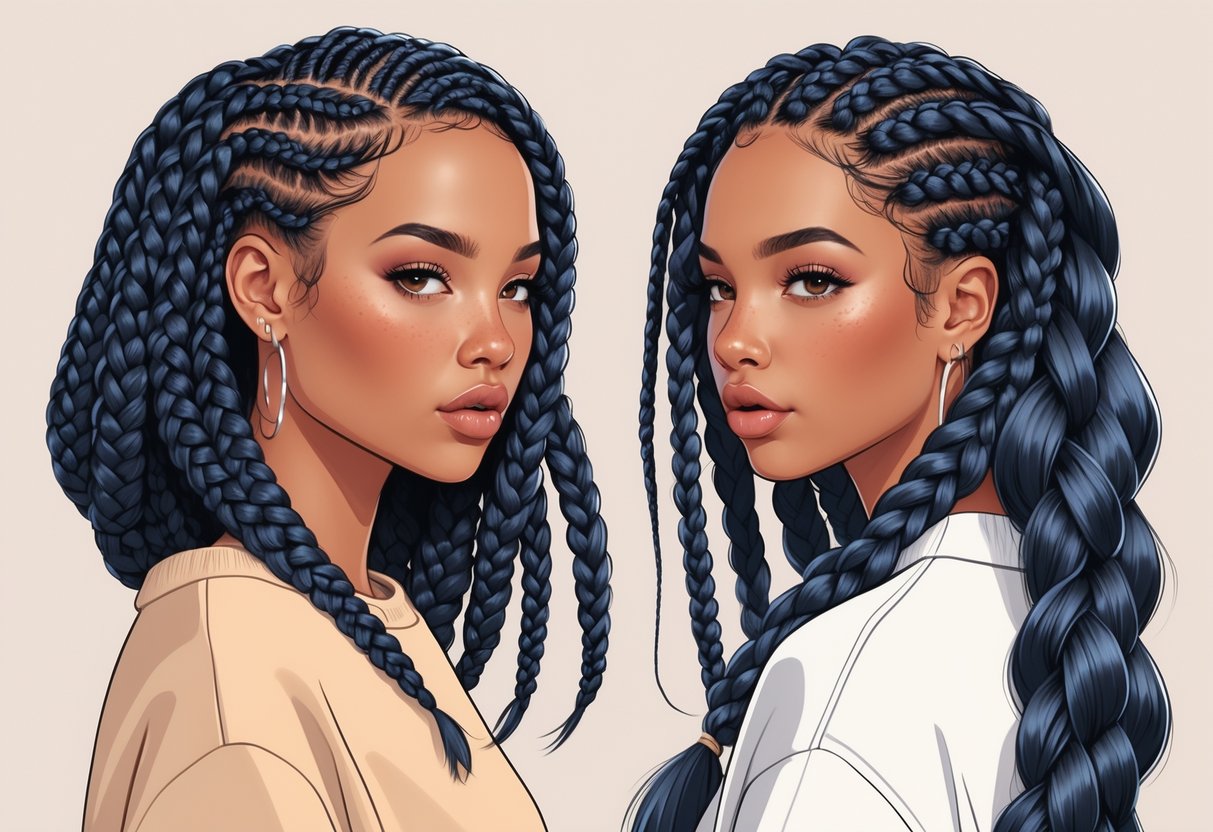
Box Braids and Jumbo Braids for Maximum Impact

Box braids and jumbo braids are among the best beginner-friendly styles because they are easy to maintain and offer a range of styling options. These protective hairstyles reduce daily manipulation and can last for several weeks with proper care.
Installing Box Braids at Home
Installing box braids at home starts with dividing the hair into small, square-shaped sections. Each section should be as even as possible for a clean, consistent look.
Beginners often use the rubber-band method to create crisp parts and secure the base of the braid. This makes the process simpler and less stressful on the scalp.
Pre-stretched braiding hair is recommended for a smoother finish and reduced tangling during the install. Braiding begins at the root, with synthetic hair added to your natural hair and woven down the length of each section.
The process can take multiple hours depending on hair length and thickness. For those new to braiding, following a step-by-step tutorial can help achieve neat results.
Styling Jumbo Braids Effortlessly
Jumbo braids use larger hair sections, making installation quicker and resulting in bold, impactful styles. The thickness of these braids lends itself well to various looks such as buns, ponytails, or half-up, half-down styles.
Accessories like beads or metallic cuffs can be added for extra flair. Effortless everyday looks include high buns, sleek low ponytails, and chunky braided crowns.
Jumbo box braids can be styled by simply manipulating their direction and gathering them into different shapes. For inspiration and ideas, platforms like Pinterest showcase hundreds of trending styles and creative variations.
Regular scalp care and nighttime wrapping with a silk scarf help maintain the style and minimize frizz.
Creative Twists for Beginners
Senegalese twists and passion twists stand out as beginner-friendly braided hairstyles. Each style comes with its own techniques and maintenance approaches suited for those new to twist braids.
Senegalese Twists Tips
Senegalese twists use synthetic braiding hair for a sleek, rope-like appearance. Beginners can achieve this look by sectioning hair into small, even parts and wrapping added hair around each section while twisting.
Consistent tension while twisting helps create uniform, long-lasting braids. For those starting out, it helps to work with pre-stretched braiding hair to minimize tangling.
Using a rat-tail comb can make sectioning more precise and neat. Keeping the scalp moisturized and washing the twists with a diluted shampoo keeps the style looking clean and fresh.
Senegalese twists can be installed in different thicknesses. Jumbo twists take less time and are less stressful on the scalp, making them ideal for those learning the basics.
Find a step-by-step tutorial or practice alongside an easy twists guide online for best results.
Exploring Passion Twists
Passion twists combine curly hair extensions and a two-strand twisting method for a textured, boho look. The main difference from Senegalese twists is the type of hair used; passion twists typically require water wave hair extensions for that natural, springy effect.
Beginners may find passion twists more forgiving since the messy, curly texture hides small mistakes. It’s important to use mousse during and after installation to prevent frizz.
Sectioning hair into medium-sized parts helps the twists fall naturally and blend easily with a variety of hair types. Passion twists hold up well as a protective style and can last up to six weeks with proper care.
Low-Maintenance Crochet Braids and Faux Locs
Crochet braids and faux locs are highly popular for their easy application and durability. These styles provide protective benefits and keep daily hair routines simple while delivering impressive hair transformations.
Getting Started with Crochet Braids
Crochet braids involve attaching pre-braided or pre-twisted hair extensions to a person’s natural hair, which is first cornrowed flat against the scalp. This technique saves time compared to traditional braiding methods and allows for a wide variety of textures, from straight and wavy to curly and coily.
Key tips for crochet braids:
- Preparation: Clean and detangle the hair thoroughly.
- Cornrowing: Make neat, evenly spaced cornrows for a uniform base.
- Installation: Use a crochet hook to loop the hair extensions under the cornrows, then secure with knots.
Low-maintenance crochet braids are known for their long-lasting wear—often up to 6-8 weeks with the right care. Routine involves light moisturizing and sleeping with a satin cap.
For visual guidance, tutorials like this video on low maintenance crochet hair options are helpful for beginners.
Beginner’s Guide to Faux Locs
Faux locs replicate the appearance of traditional locs using synthetic or human hair extensions. They are a versatile protective style that can be installed using the crochet method or other wrapping techniques.
Beginners can opt for pre-looped faux locs for faster and easier application. Important steps for installing faux locs:
- Sectioning: Divide hair into equal sections to ensure even distribution.
- Base Braiding: Create individual braids or twists as the anchoring base.
- Attaching Locs: Either crochet pre-made locs or wrap extension hair around each base braid.
Faux locs are celebrated for their longevity and low upkeep. Maintenance includes gentle scalp care and avoiding excessive manipulation.
Guides such as this easy faux locs tutorial give step-by-step instructions tailored for first-time users.



